
Marquette is the county seat of Marquette County and the largest city in the Upper Peninsula of the U.S. state of Michigan. Located on the shores of Lake Superior, Marquette is a major port, known primarily for shipping iron ore from the Marquette Iron Range. The city is partially surrounded by Marquette Township, but the two are administered autonomously.

The Upper Peninsulaof Michigan – also known as Upper Michigan or colloquially the U.P. – is the northern and more elevated of the two major landmasses that make up the U.S. state of Michigan; it is separated from the Lower Peninsula by the Straits of Mackinac. It is bounded primarily by Lake Superior to the north, separated from the Canadian province of Ontario at the east end by the St. Marys River, and flanked by Lake Huron and Lake Michigan along much of its south. Although the peninsula extends as a geographic feature into the state of Wisconsin, the state boundary follows the Montreal and Menominee rivers and a line connecting them.

Marquette County is a county located in the Upper Peninsula of the U.S. state of Michigan. As of the 2020 Census, the population was 66,017. The county seat is Marquette. The county is named for Father Marquette, a Jesuit missionary. It was set off in 1843 and organized in 1851. Marquette County is the largest county in land area in Michigan, and the most populous county in the Upper Peninsula of Michigan.
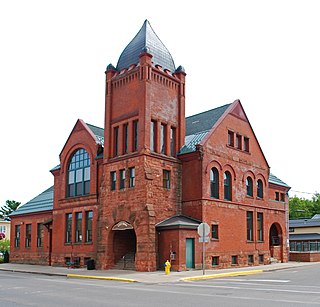
Ishpeming is a city in Marquette County in the Upper Peninsula of the U.S. state of Michigan. The population was 6,140 at the 2020 census, less than it was in the 1950s and 1960s when the iron ore mines employed more workers. A statue of a Native American figure, erected in 1884 in the small town square, is referred to as "Old Ish".

Negaunee is a city in Marquette County in the U.S. state of Michigan. The population was 4,627 at the 2020 census. The city is located at the southwest corner of Negaunee Township, which is administratively separate, in the Upper Peninsula. The city is home to a luge track. The name Negaunee comes from an Anishinabemowin (Ojibwa) word nigani, meaning "foremost, in advance, leading," which was determined to be the closest Ojibwa translation for "pioneer". Within the city limits is Teal Lake.
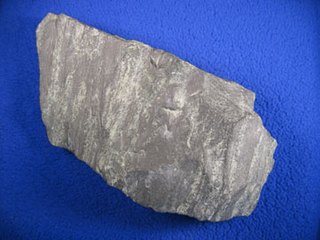
Taconite is a variety of iron formation, an iron-bearing sedimentary rock, in which the iron minerals are interlayered with quartz, chert, or carbonate. The name "taconyte" was coined by Horace Vaughn Winchell (1865–1923) – son of Newton Horace Winchell, the Minnesota State Geologist – during their pioneering investigations of the Precambrian Biwabik Iron Formation of northeastern Minnesota. He believed the sedimentary rock sequence hosting the iron-formation was correlative with the Taconic orogeny of New England, and referred to the unfamiliar and as-yet-unnamed iron-bearing rock as the 'taconic rock' or taconyte.

The Cuyuna Range is an inactive iron range to the southwest of the Mesabi Range, largely within Crow Wing County, Minnesota. It lies along a 68-mile-long (109 km) line between Brainerd, Minnesota, and Aitkin, Minnesota. The width ranges from 1 to 10 miles.
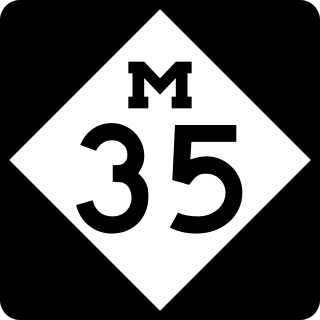
M-35 is a state trunkline highway in the Upper Peninsula (UP) of the US state of Michigan. It runs for 128 miles (206 km) in a general north–south direction and connects the cities of Menominee, Escanaba, and Negaunee. The southern section of M-35 in Menominee and Delta counties carries two additional designations; M-35 forms a segment of the Lake Michigan Circle Tour, and it is the UP Hidden Coast Recreational Heritage Trail, which is a part of what is now called the Pure Michigan Byways Program. Along the southern section, the highway is the closest trunkline to the Green Bay, a section of Lake Michigan. The northern section of the highway turns inland through sylvan areas of the UP, connecting rural portions of Delta and Marquette counties.

Business M-28 is a state trunkline highway serving as a business route that runs for approximately 4.9 miles (7.9 km) through the downtown districts of Ishpeming and Negaunee in the US state of Michigan. The trunkline provides a marked route for traffic diverting from U.S. Highway 41 (US 41) and M-28 through the two historic iron-mining communities. It is one of three business loops for M-numbered highways in the state of Michigan. There have previously been two other Bus. M-28 designations for highways in Newberry and Marquette.
The Lake Superior and Ishpeming Railroad, is a U.S. railroad offering service from Marquette, Michigan, to nearby locations in Michigan's Upper Peninsula. It began operations in 1896. The LS&I continues to operate as an independent railroad from its headquarters in Marquette.
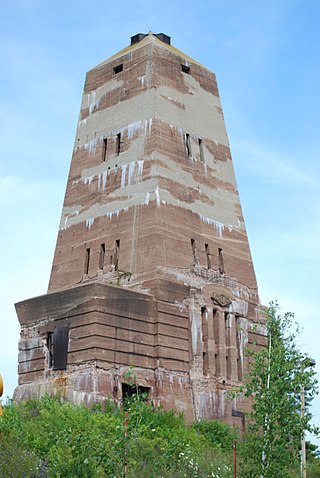
The Cliffs Shaft Mine Museum is a former iron mine, now a heritage museum, located on Euclid Street between Lakeshore Drive and Spruce Street in Ishpeming, Michigan. The museum, operated by "Marquette Range Iron Mining Heritage Theme Park Inc.", celebrates the history of the Marquette Iron Range. The site was designated a state of Michigan historic site in 1973 and placed on the National Register of Historic Places in 1992.
Cleveland-Cliffs Inc., formerly Cliffs Natural Resources, is a Cleveland, Ohio-based company that specializes in the mining, beneficiation, and pelletizing of iron ore, as well as steelmaking, including stamping and tooling. It is the largest flat-rolled steel producer in North America.
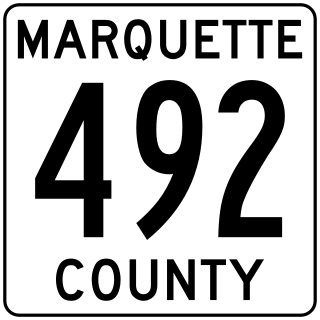
County Road 492 is a primary county road in Marquette County, Michigan. The road serves as an alternate route between Negaunee and Marquette. Several historic sites line the roadway as it runs south and parallel to the main highway, U.S. Highway 41 (US 41) and M-28, through the Marquette Iron Range in Michigan's Upper Peninsula. The path of the road runs near tracks of the Lake Superior and Ishpeming Railroad (LS&I). The locally created Iron Ore Heritage Trail will follow CR 492 through Eagle Mills and Morgan Meadows upon completion. The western terminus of the county road is on US 41/M-28 in Negaunee and the eastern end is in Marquette next to Lake Superior.

The Jackson Mine is an open pit iron mine in Negaunee, Michigan, extracting resources from the Marquette Iron Range. The first iron mine in the Lake Superior region, Jackson Mine was designated as a Michigan State Historic Site in 1956 and listed on the National Register of Historic Places in 1971. The Lake Superior Mining Institute said, the mine "is attractive in the iron ore region of Michigan and the entire Lake Superior region, because of the fact it was here that the first discovery of iron ore was made, here the first mining was done, and from its ore the first iron was manufactured." Multiple other mines soon followed the Jackson's lead, establishing the foundation of the economy of the entire region. The mine is located northwest of intersection of Business M-28 and Cornish Town Road.

The Cleveland Mine Engine House Number 3, also known as the Brownstone Engine House, is a building located at 601 Division Street in Ishpeming, Michigan. It was built to house engines hoisting ore from various Cleveland Mine locales, and was listed on the National Register of Historic Places in 2007.
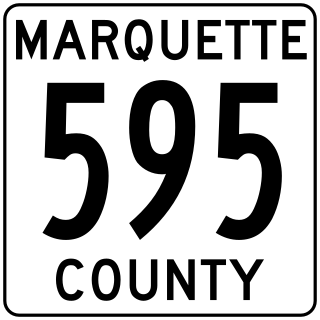
County Road 595 was a proposed primary county road in Marquette County in the US state of Michigan. The road would have provided access from the northern part of the county, near the Eagle Mine in Michigamme Township, to US Highway 41 (US 41) and M-28 in Humboldt Township. The approximately 21.5-mile-long (34.6 km) road would have been used primarily for commercial truck traffic hauling rock from the Eagle Mine to a processing facility south of US 41/M-28 in Humboldt Township. At present, such traffic has to use existing county roads which involves passing through the cities of Marquette, Negaunee, and Ishpeming. The northern end would have been northeast of the mine in Champion Township at an intersection with the Triple A Road.
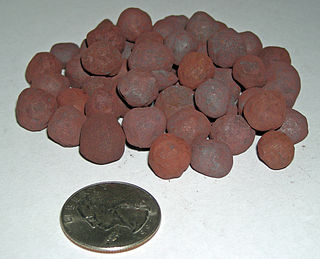
Iron mining in the United States produced 48 million metric tons of iron ore in 2019. Iron ore was the third-highest-value metal mined in the United States, after gold and copper. Iron ore was mined from nine active mines and three reclamation operations in Michigan, Minnesota, and Utah. Most of the iron ore was mined in northern Minnesota's Mesabi Range. Net exports were 3.9 million tons. US iron ore made up 2.5 percent of the total mined worldwide in 2015. Employment as of 2014 was 5,750 in iron mines and iron ore treatment plants.
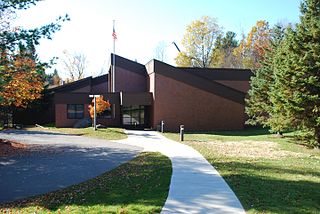
The Michigan Iron Industry Museum, a branch facility of the Michigan Historical Center, is a community museum serving the heritage of the Marquette Iron Range on Michigan's Upper Peninsula. The museum is located in Negaunee, a town built atop the geological strata of the iron range near Marquette. Until recently, Negaunee was a one-industry town that centered on the mining of iron ore. The Negaunee region served as the center of U.S. iron ore production from about 1880 until approximately 1900, when this role was taken over by iron mines on Minnesota's Mesabi Iron Range. The Michigan Iron Industry Museum opened in 1987 close to the Carp River Forge site on the Carp River where Michigan iron ore was first forged in 1848.
The Iron Ore Heritage Trail is a 47-mile (76 km) bicycle and hiking trail in Michigan that presents a look at some of the key sites of human and geological heritage on the Marquette Iron Range. Trailheads are located at the Marquette Welcome Center in Marquette, and in Republic west of Marquette. The trail, which has a comparative change in elevation of 1,000 feet (300 m) covers much of the length of the Marquette Iron Range, a historically and commercially significant range of hematite and magnetite mined for more than 150 years as iron ore. The trail celebrates the geological and human heritage of the Marquette Iron Range, which dominated U.S. iron ore production from approximately 1880 until about 1900. Many of the buildings visible from the trail date back to this period of Victorian architecture. Additional focal points/parking lots for the trail are located at midpoints at the Michigan Iron Industry Museum in Negaunee and the Cliffs Shaft Mine Museum in Ishpeming.

Blackrocks Brewery is a craft brewery in Marquette, Michigan. Taking the name from a local landmark, David Manson and Andy Langlois opened Blackrocks in 2010 as a nanobrewery within a Victorian-style house. As of 2020, Blackrocks is the tenth-largest brewery in Michigan with sales across the state's Upper and Lower Peninsulas and into the adjoining state of Wisconsin.


















